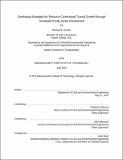| dc.contributor.advisor | Frederick Salvucci and John Attanucci. | en_US |
| dc.contributor.author | Gordon, Michael A. (Michael Andrew) | en_US |
| dc.contributor.other | Massachusetts Institute of Technology. Department of Civil and Environmental Engineering. | en_US |
| dc.date.accessioned | 2015-10-30T18:34:33Z | |
| dc.date.available | 2015-10-30T18:34:33Z | |
| dc.date.copyright | 2015 | en_US |
| dc.date.issued | 2015 | en_US |
| dc.identifier.uri | http://hdl.handle.net/1721.1/99547 | |
| dc.description | Thesis: S.M. in Transportation, Massachusetts Institute of Technology, Department of Civil and Environmental Engineering, 2015. | en_US |
| dc.description | This electronic version was submitted by the student author. The certified thesis is available in the Institute Archives and Special Collections. | en_US |
| dc.description | Cataloged from student-submitted PDF version of thesis. | en_US |
| dc.description | Includes bibliographical references (pages 183-198). | en_US |
| dc.description.abstract | Many transit agencies are facing budgetary, institutional, physical infrastructure, and vehicle constraints, which all tend to restrict agency service growth. This research proposes strategies that allow transit agencies to ease these constraints to enable growth through increased private sector involvement. It suggests that the primary attractiveness of engaging the private sector is not to provide the same service at a lower cost, but to significantly increase service capacity and quality while facing these constraints. In the recent past, U.S. advocates of private production of transit services have generally promoted contracting primarily as a cost saving method. However, any immediate savings may or may not continue into the long-term, during which the public agency also loses the capacity to produce the service in-house. The alternate view presented here is that the real value of increasing private sector involvement in public transit stems from the substantial improvements in service quality, effectiveness and speed of implementation, and the ability to secure private partners who become new stakeholders and who support funding for increased levels of service. Transit growth is particularly necessary in cities with rapidly growing areas. In these cases, continued development requires increasing levels of transit service. The Boston metropolitan area has multiple districts where new development is surging. Meanwhile, Boston's Massachusetts Bay Transportation Agency faces numerous constraints that will limit its ability to grow its agency-operated service to the extent desired to allow for rapid development. In spite of this, Massachusetts needs to take advantage of new development in the Boston area in order to reach its economic growth objectives and statewide target of tripling the non-auto modal share by 2030. This thesis presents the conceptual foundation of operating and funding new service through the private sector, and better coordinating with existing private operators. After suggesting strategies for transit growth through increased private sector involvement, it applies these strategies to opportunities in the resource-constrained Boston region. These ideas could also be easily applied to similar opportunities in resource-constrained agencies across the U.S and internationally. | en_US |
| dc.description.statementofresponsibility | by Michael A. Gordon. | en_US |
| dc.format.extent | 198 pages | en_US |
| dc.language.iso | eng | en_US |
| dc.publisher | Massachusetts Institute of Technology | en_US |
| dc.rights | M.I.T. theses are protected by copyright. They may be viewed from this source for any purpose, but reproduction or distribution in any format is prohibited without written permission. See provided URL for inquiries about permission. | en_US |
| dc.rights.uri | http://dspace.mit.edu/handle/1721.1/7582 | en_US |
| dc.subject | Civil and Environmental Engineering. | en_US |
| dc.title | Developing strategies for resource-constrained transit growth through increased private sector involvement | en_US |
| dc.type | Thesis | en_US |
| dc.description.degree | S.M. in Transportation | en_US |
| dc.contributor.department | Massachusetts Institute of Technology. Department of Civil and Environmental Engineering | |
| dc.identifier.oclc | 925486156 | en_US |
